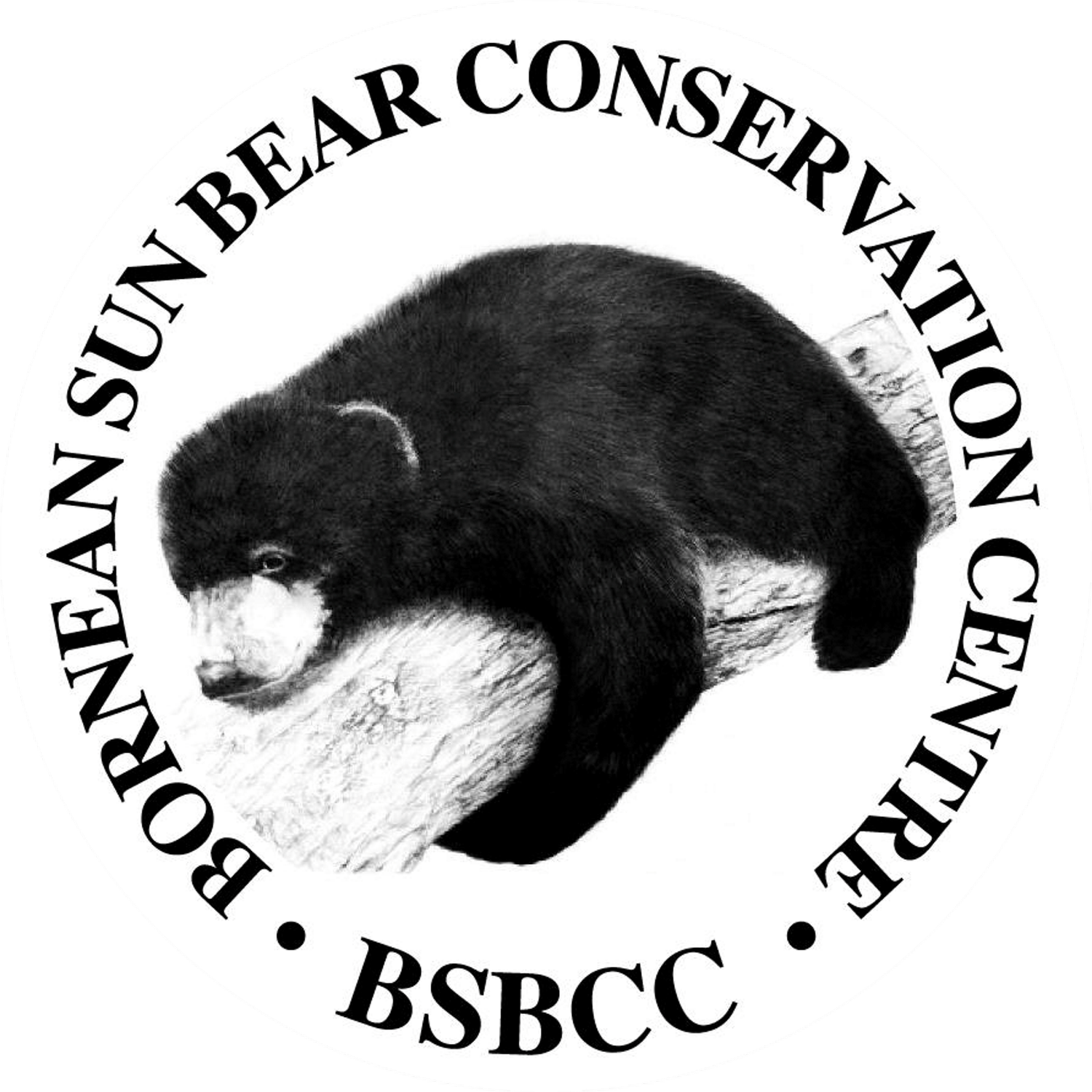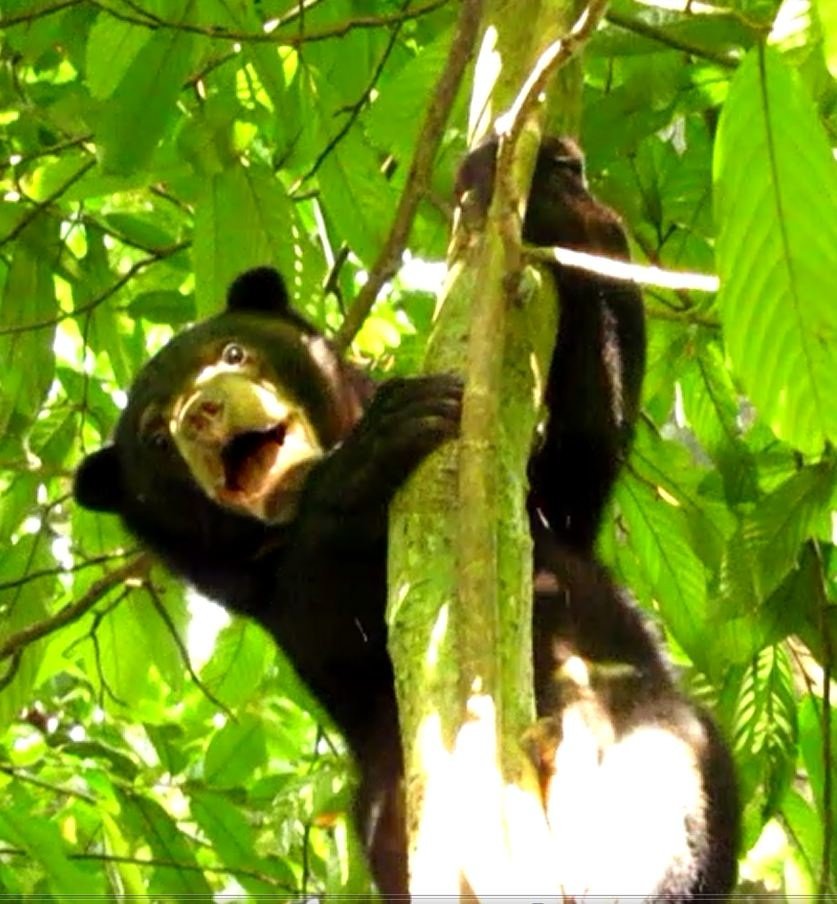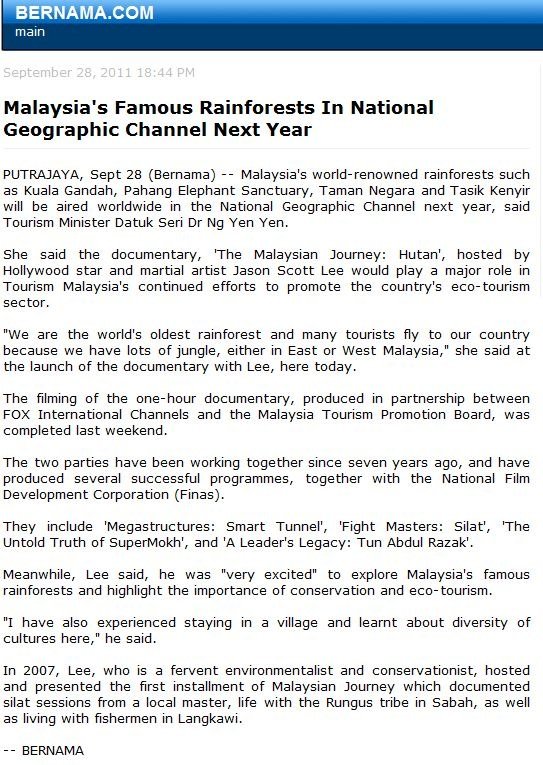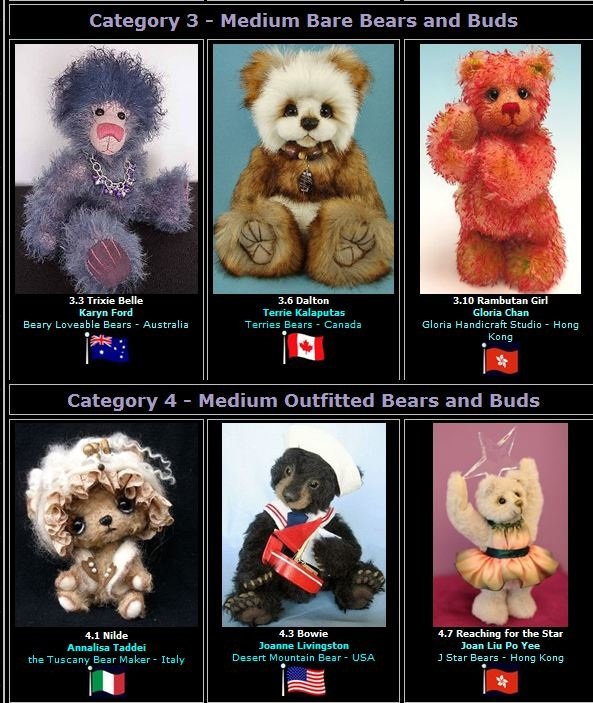Big tree little bear and tiny termites
It all begins with an idea.
Text, photos, and video by Siew Te Wong
[kml_flashembed movie="http://www.youtube.com/v/W9bY92nVdPo" width="425" height="350" wmode="transparent" /]
Yesterday when I walked little Mary in the forest, she stopped at the base of this huge dipterocarp tree. The scene was just amazed me: "big tree, little bear" was what came out from my mind immediately. It was a peaceful time we spent in the forest under the big tree. Mary was busy digging the nests of termite and ant and feeding furiously on the angry insects that swamped out from their broken home. The big tree stood there like a giant with no fear. The sound of the cicadas and other unknown insects rumbled like there is no tomorrow: they have to mate now!
The big tree, the little sun bear, and the tiny termites all need one other to survive. Female sun bears den in the hollowed tree trunk or cavities of huge trees in the forest when they give birth and nurse helpless baby for months. These cavities are the safest den for the female sun bears because they are relatively dry in the ever wet and moist rainforest (rainforest always rain!), relative cold in the hot mid tropical day, and relatively warm at night (tropical rainforest may get cold at night because of the rain and high humidity). There is simply no other better den site that a sun bear can find in the forest then a large tree with cavities or hollowed. The trees are huge, like this one, with a diameter of at least one meter (3 feet) and a height of 30 m (100 feet) or more. They are probably very old - at least few hundred years old too! In return, sun bears are opportunistic omnivores that feed on termites, beetles and other forest insects that kill trees (forest pest, so to speak). By feeding on the termite colonies and other insects, the sun bears act as forest "doctors" that keep these insects at "healthy levels". The tiny termites, feed on the woody materials in the forest, both alive and dead. And the cycle go on and on..
Here comes a problem for sun bear in the human altered landscape: these forest giants are getting rare in logged forest because they are targeted for timber market and sell for a lot of money. In Borneo, most of the remaining forests are being selectively logged except few totally protected forest reserves that remain as undisturbed primary forests. The lack of large trees with cavity may post a challenge for female sun bears to find suitable den sites and successfully raise cubs.
Big trees little bears and tiny termites, all need one other to survive. Are we wise enough to keep all of them in the forest? For sure the termites will survive. But I am not sure about the sun bears and the big trees. Only time will tell!
Is Mary climbing on a vertical wall?
Mary digging out a termite colony in this fallen tree.
Still working hard...
This hollowed tree was being fell by logger but abandoned because of the hollowness and low value. The cavity has become an important den site for sun bear.
I found one of my studied wild sun bear in this cavity of a huge standing tree.
The integration of Fulung and Mary
It all begins with an idea.
Fulung (left) and Mary (right) play together for the first time.
"The best enrichment for a captive sun bear is another sun bear, if they get along well" is what I believing in now. In the past when I studied wild sun bears in the forest, they always have solitary lifestyle for a good reason: food in the forest is always scarce and not enough to feed many mouths. However, their solitary behavior may change when they are at a fruiting fig tree where fruits (food) are over abundance in a short period of time.
Sun bears are very much like the orangutans. Orangutans are the only great apes that live solitarily, at least most of the time. For great apes (two species of chimpanzees, two species of gorillas, and two species of orangutans), there are many benefits to live as a social/family group. However, because of the food scarcity in the rainforest of Borneo and Sumatra in general, they have no choice but to have a solitary lifestyle. Few weeks ago, I saw three sub-adult orangutans on a fruiting tree. They fed on the fruits of the tree when they were hungry and played and hang-around together for few days. The fruit tree attracted the orangutans far away for the feast (orangutans are important seed dispersers), but at the same time give them the opportunity to meet one another.
When I did my wild sun bear studies, I spent up to few months trying to trap them in the forest. Once I trapped them, I sedated them, put a radio-collar, collected some biological samples, and released them after an hour or two of handling episodes. My jobs thereafter were to track them down in the forest. Some of them I never got to see them again. Few of them, on very lucky circumstances, I observed them for few seconds through the thick vegetation. All of the evident that I collected from the wild sun bears indicated that they were solitary, except in one occasion: fruiting fig tree where few sun bears and other wildlife feast on a same tree. This is why I believe sun bears in the wild are solitary.
After I set up Bornean Sun Bear Conservation Centre, I have the opportunity to observe many sun bears up close and personal. These captive sun bears display a very unique behavior that is very different from what I learned from the wild bears: they are social. They love to social. They love to interact and play with one another, just like the three wild orangutans I saw few weeks ago in the forest. The biggest reason for this social behavior in captivity is because food is not limited and they do not have a reason to compete for food. However, they have a hierarchy status and personality where this bear will never get along with that bear, etc. In short, observing these bears slowly convince me that sun bear are social animals.
Anyway, back to Fulung and Mary. These two cubs were rescued and sent to BSBCC on August 15th and September 12th, respectively. Now their quarantine periods have over and both proved to be healthy. Today we integrated them for the first time. Both of them are being housed next to each other separated by barred wall, plus a wooden plank so that they have no contact with each other. Few days ago, we removed the plank so that they have contacts through the bars. They show interest on each other. Sniffing, licking, and occasionally playing through the bars.
Today is the big day. I opened the door in between the two dens. During the first 10 minutes they just ignored each other like the other bear never exist. What interest Fulung most was Mary's den; and what interest Mary was Fulung's den. They checked out every corner and inches in the den. Then, Fulung walk passed Mary and suddenly realized that Mary was in his den. Mary also realized that Fulung was physically there. Fulung used his head to push Mary, and Mary used her paws to scratch Fulung. They finally get into a play fight that looks violent, but totally harmless and silent. Two furry balls were wrestled first on the floor. Then Mary who was disadvantaged by her smaller size, always being pushed down and tried to escape Fulung's bites. She finally climbed into Fulung's sleeping basket and Fulung followed. Both of them spend the next 30 minutes biting, kicking, wrestling, slapping, and pushing (Fulung pushed Mary with his bigger body). Because of Mary smaller size and weaker in strength, we decided to separate them after 30 min and call it a day. We will continue the integration tomorrow.
For Mary and Fulung, both orphaned as a result of their mother (probably) being killed, and they being captured as pets, the best enrichment toys for their life in captivity are the companionship of each other. The playing, biting, wrestling, and fighting (seem violence but not destructive) help their social skills at the same time improve the development of the muscle, agility, and growth. All of these are important elements in the long process of development to become adult and healthy sun bears.
Please help us help Fulung, Mary and other sun bears that we rescued and care at Bornean Sun Bear Conservation Centre. At the moment our operation fund is at a record low and we are desperately needs your help in many ways. You can donate online at:
http://www.leapspiral.org/content/support_leap.php (select "Donate" to Bornean Sun Bear Conservation Centre)
http://www.causes.com/causes/95651-bornean-sun-bear-conservation-centre (click "Give")
Siew Te Wong
Oct 24, 2011
Mary (right) biting Fulung's ear :)
Two furry balls wrestling for 30 minutes during their first meeting.
Fulung (left) and Mary (right) play biting with each other.
Mary (left) used her head to stop Fulung (right)'s kicks.
Although smaller in size, Mary (left) stands her ground on Fulung's wrestle.
Fulung (top) is advantages from his larger size than Mary.
The wrestling between Mary (top) and Fulung was non-stop for 30 min.
Fulung (top) riding on Mary.
Fulung being larger dwarfed Mary and dominant the wrestling.
Sun Bear Diary: Fulung in the forest
It all begins with an idea.
Time flies! It has been more than two months we had rescued Fulung and nurse him. Over the past two months, he gained 10 kg, from 7.8 kg when he first came, to 17.5 kg as of yesterday. This video was taken yesterday when I walked him in the forest. There were a lot more clips that I took of Fulung doing some amazing things in the forest. I am not good at video editing nor have time to do it. What I did is do a quick and simple editing and post it up. Hope you like it!
[kml_flashembed movie="http://www.youtube.com/v/q6bIIQPskWs" width="425" height="350" wmode="transparent" /]
Sun Bear Diary - Mary and ants
It all begins with an idea.
This is something that I wanted to do every time I walk one of our sun bear cubs in the forest: I want to upload and post the videos that I took (literally hundreds of them if not thousands already) of the bears doing their "things" in the forest and share them to the world. However, I am always facing the dilemma of finding enough time to do so. :(
Yesterday I walked Mary the sun bear for the first time after being away for 3 weeks (our stuff and volunteer walked her during my absence) in the forest like before. We had a great time together in the forest (although both the leeches and mosquitoes were really bad because of the heavy rain we had lately). Although she still wanted to suck my finger once in a while to seek comfort, her condition is much better compare to last month when she first came here. She moved much faster and more agile. Good news for sure.
I hope I can find more time to upload and catch up with editing and uploading the videos on internet so that you all can see their special behavior and illusive life style. Stay tuned and enjoy the video!
[kml_flashembed movie="http://www.youtube.com/v/EEdk9xxJrPA" width="425" height="350" wmode="transparent" /]
The construction of the observation platform finally started!
After the completion of the first bear house and the forest enclosures one and a half year ago, Bornean Conservation Centre has been quiet down from major construction. The quietness is gone now as another phase of construction started few weeks ago. Thanks to the fund raising efforts from Sabah Wildlife Department, The Ministry of Tourism Malaysia has kindly provided us with funding to build the observation platform, the elevated board walk that link the car park to the observation platform, and to upgrade the access road to the bear house. The construction for this project will take six months and scheduled to be completed on March 2012. After completion of these constructions, we will start to prepare the education materials and displays, and get ready to welcome our first visitor on July next year.
With the funding secured and the construction for the observation platform and the board walk in place, our remaining tusk is to raise sufficient funds to construct the second bear house, visitor briefing area, and renovation of the office area and the bear holding area. The completion of these components is crucial for the success for BSBCC to conserve sun bear through a combination of education, rehabilitation, research, and improve the welfare of captive orphaned sun bears.
Please help us spread the words and spread the loves to the sun bears. Please do what you do best to help us. We have come this far in our mission to conserve sun bear in many ways because of your supports and helps. And yes, we still need your help!
The schematic diagram of the observation platform at BSBCC. Visitors can view the sun bears in their natural surrounding from this platform. This is the location where "everyone can see sun bears in the forest" take place!
Translation on this notice board erected at the junction of Sepilok:
Project: Construction Project for Bornean Sun Bear Conservation Centre, Sipilok, Sabah
Owner/Client: Sabah Wildlife Department (Ministry of Tourism, Culture, and Environment)
Pay by: Ministry of Tourism Malaysia
Architect: Summaz Architect
Engineer: Perunding Menara Co. Ltd.
QS: Consultant LCF
Contractor: Dayana Enterprise
Date Construction Start: 09-09-2011 Date construction end: 09-03-2012
The current construction involves the building of the Observation Platform, Visitor access walkway from car park, and road to the bear house (yellow). We still need funding to build the Bear House 2 and Forest Enclosure 2, Visitor briefing area, and Bear Holding Area.
At Last - Bearing up in the UK!
Sunday 18th September was a momentous day for Sun Bear Conservation Trust (SBCT UK). Finally, Anna Cocker of SBCT UK met up with Paul Clenton. Paul has also worked at BSBCC and like Anna is promoting sun bear conservation and fundraising in the UK. The meeting took place at Cannock Chase close to Stafford, West Midlands, England which has been designated as an Area of Outstanding Natural Beauty due to its remarkable range of habitats and wildlife.
Throughout the day, Anna and Paul shared their sun bear experiences and, exchanged lots of great ideas for the trust. They plan to work together to successfully develop SBCT and ensure that sun bear conservation is widely promoted throughout the UK. A truly inspiring and motivating meeting!
If you would like to become involved with SBCT and help to raise awareness and fundraise for sun bears in the UK then please contact Anna Cocker on annaecocker@yahoo.co.uk.
The first meeting between Anna and Paul gave hope for sun bear conservation in UK!
Jason Scott Lee loves sun bears, how about you?
http://www.bernama.com.my/bernama/v5/newsindex.php?id=616376
One of the locations where Jason Scott Lee visited during the production of this documentary was Bornean Sun Bear Conservation Centre in Sepilok, Sandakan, Sabah. He and his production team spent one full day filming at the centre last week. Jason had a good time working with the sun bears and learning about this little known bears.
Jason started his day by cleaning the bear den. "Cleaning" may not be the best way to start anyone' day. However, to our Hollywood start Jason, cleaning bear feces, enrichment debris, food waste and others, was a good way to introduce the audience the amount of work load for taking care of these captive sun bears. After the cleaning, Jason and I cut two big buckets of fruits which we scattered fed to the sun bears in the forest enclosures later in that morning. All of the sun bears in the forest enclosures came out to greet us and feast on the fruits.
Jelita came out from the dense forest to say hi!
After lunch, we "walked" Mary the sun bear cub in the forest. Jason was surprised to see how attached Mary was on to me. "In the wild, sun bear cubs have to attach and follow their mother closely when they foraging in the forest. These orphan cubs do what their instinct tells them: following their mom". I explained. "Without the proper protection from mom, they probably will not make it to adulthood." The difference now for Mary, as an orphan, is that she has no mother to follow except me. I am her surrogate mother when I walk her in the forest. She has no choice but to trust me and put her faith onto me.
The other instinct that all sun bear cubs possess is the instinct of finding food in the forest. Beside fallen fruits, invertebrates such as termites, ants, earthworms, etc., are natural food that sun bears feed on in the wild. Although Mary walked slowly and moved slowly due to her malnutrition problem, she still has strong instinct of finding insects and invertebrates in the forest. That afternoon Jason and I observed Mary did a lot of digging and breaking into termite and ant nests, and spent the afternoon feeding on them. Good work Mary!
Mary the sun bear cub do what she do best in the forest- digging!
We hope Jason like other Hollywood celebrities who have visited BSBCC and learned more about the plights of the sun bears can help us spread the words about our works to conserve sun bears. Sun bears remain the least known bears in the world. The challenge for the conservation of sun bears is to overcome the very first step: let the public know about sun bear!
Jason now knows about sun bear and loves sun bears. I hope Jason's fans will do the same too! How about you?
Cerah Won!
Host by Bears&Buds, The Largest Online Monthly Teddy Bear Magazine Circling the Earth, The Sixth Annual URSA Awards Competition is an international stuffed toy animals contest that participated by high-quality stuffed toy animal makers (artists) around the world. This year Maria Collin from Germany entered the competition by making a staffed sun bear name "Carah" base on Cerah the sun bear from BSBCC to raise fund and awareness for BSBCC and the plights of the sun bear in SE Asia.
And the Winner is..... CERAH!!
Yes, Cerah won the first place at the "Large bare bears and buds" category!
Congratulation to Maria for the job well done and Thank You for helping to raise awareness for sun bear and BSBCC!
(see.. another good example of "do what you do best to help sun bears!")
Here is what Maria got to say to the rest of the world:
Maria Collin
Puca Bears
Wald-Michelbach, Hesson Germany
I am thrilled to be amongst the URSA winners again, especially as this Sun bear was a "first" for me and definitely outside of my comfort zone - all those wrinkles! I probably developed a few more myself, trying to get hers right.
I made "Cerah" as a prize for a recent fundraiser, for the Bornean Sun Bear Conservation Centre as my contribution to their efforts to raise awareness of, and to care for, these desperately threatened and utterly enchanting little bears.
Coming from a part of the world where real bears were hunted out long ago, it took teddy bears to guide me into the world of their real counterparts.
Creating "tribute" bears like my Cerah Sun bear is my way of expressing my appreciation for their inspiration - and looking at the real Cerah, who could fail to be inspired?
My grateful thanks to all who voted for her; it means such a lot to me!
And huge thanks too, to Valerie and Bears&Buds, for a super competition - and to all the other competitors - it's always a privilege to be amongst you all.
Hugs, Maria
Here are the finalists of the competition:
http://www.cyberdendesigns.com/URSA-2011/FinalistinURSAAwardsCompetitionbyBearsandBudsTeddyBearMagazine.htm
Enlighten yourself on sun bears at BSBCC
Original posted at http://thestar.com.my/news/story.asp?file=/2011/10/2/nation/9617882&sec=nation
By ISABELLE LAI
isabellelai@thestar.com.my
KUALA LUMPUR: Animal lovers can learn more about the elusive and endangered Malayan sun bear (pic) when the visitor’s platform at the Borneo Sun Bear Conservation Centre (BSBCC) in Sabah is ready.
BSBCC chief executive officer and wildlife researcher Wong Siew Te said construction of the platform has just begun and it was expected to open in June, next year.
He said little was known about the sun bear, which is the smallest bear species in the world and one of the rarest.
“The sun bear’s name comes from its distinctive golden-coloured chest patch, which resembles the sun,” he said during his talk on the bear at the Malaysian Nature Society headquarters yesterday.
He lamented that few Malaysians knew the importance of conserving this “wonderful, playful animal”, which faces extinction through illegal poaching and habitat destruction.
BSBCC is focused on rehabilitation, conservation, education, research and welfare of sun bears, he said.
Photos: Christopher Leo
Jason’s ‘Malaysian Journey’
Original posted at http://thestar.com.my/news/story.asp?file=/2011/9/29/nation/9597708&sec=nation
PUTRAJAYA: Hollywood star Jason Scott Lee famous for his portrayal of kung fu film legend Bruce Lee will host the second series of the Malaysian Journey documentary to promote Malaysia's eco-tourism sector.
“Malaysia's diverse ethnic groups and culture are simply captivating.
“There is so much beauty in your country that needs to be shared with the world,” he said at the sneak preview of the upcoming documentary called Hutan organised by the Tourism Ministry.
The one hour documentary, scheduled for broadcast early next year, will feature the Kuala Gandah Elephant Sanctuary, Taman Negara National Park, Tasik Kenyir Lake, Gunung Mulu National Park and the Bornean Sun Bear conservation centre in Sabah.
Captivating Malaysia: (From left) Fox International Channels senior vicepresident Simeon Dawes, Ng, Jason and Fox International Channels director and territory head (Malaysia) Basil Chua at the launch of ‘Malaysian Journey’ at Pullman Hotel, Putrajaya.
In 2007, Jason hosted the first instalment of Malaysian Journey where he shared his experiences with the Semelai people in Pahang, silat sessions, life with the Rungus tribe in Sabah, abseiling in Mount Kinabalu and living with fishermen in Langkawi.
It was broadcast on National Geographic Channel global network, reaching over 300 million households and televised in 166 countries and in 32 languages.
Tourism Minister Datuk Seri Dr Ng Yen Yen said in her speech that the Government remains committed to conserving Malaysia's nature through sustainable tourism.
“Our eco-tourism policy states that no more than 50% of our rainforest can be developed. This is to ensure that our forests are well-protected,” she said.
In KOTA KINABALU, Jason volunteered to help put the finishing touches to a house in Kampung Lingubang in Kota Belud, about 150km from here, on Monday, before presenting the keys to home owner, 44-year-old Jenik Ladsou.
It was part of a programme by volunteer group Habitat for Humanity Malaysia to provide houses for poor families.
Jason, who lives in his native Hawaii with Singapore-born wife Diana Chan and their 15-month-old daughter, said he still remembered the first time he came to Sabah three years ago when he climbed Mount Kinabalu and shot a documentary.
“I still remember the pain and agony of coming down from the mountain,” he smiled.
















































